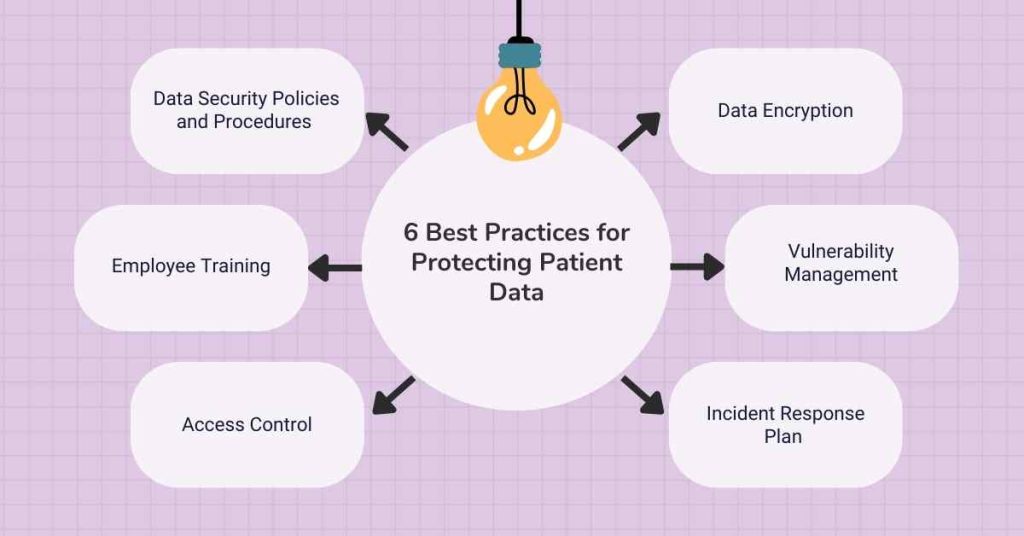Health care in the modern world greatly depends on electronic health information (EHI) and the connections between medical devices. As much as this technology transforms patient care, cyber security comes with another significant challenge. Preserving the patient’s data and medical-related items from cyber criminals is not an option but a necessity.
In this article, we have talked about Cybersecurity in Healthcare: Protecting Patient Data and Medical Devices
Why is Healthcare Cybersecurity Important?

Before going into the main topics let’s see Why is Healthcare Cybersecurity Important?
The healthcare industry sits on a gold mine of data for hackers. Protected Health Information stored in EHRs includes patients’ names, addresses, Social Security numbers, diagnoses, medications that have to be given to the patient, and even financial data. This information can be utilised for identity theft, for making fraudulent medical claims, or for blackmailing the patient.
Moreover, medical devices are now able to interface with networks and hence can be accessed remotely with undesirable effects. This is because hackers could easily gain control of these devices and malfunction critical procedures or endanger the lives of patients.
The Impacts of a cyber attack on a healthcare organization are very severe. It can result in:
1. Loss of patient trust
Leakage demoralises the patients and their confidence in the healthcare system.

2. Financial penalties
There are usually strict penalties that regulatory bodies set for noncompliance with the laid down data security policies.
3. Disruption of care
Computer viruses in healthcare settings are a threat to any administrative, clinical or technical processes in the delivery of care and can stall, or even stop important surgeries.
4 Common Threats in Healthcare Cybersecurity

Healthcare organizations face a diverse range of cyber threats, some of the most common threats are:
1. Ransomware
This malicious software encrypts data, essentially locking the victim out of their systems. Attackers then demand a ransom payment in exchange for a decryption key. Healthcare organizations are prime targets for ransomware attacks due to their critical data and time-sensitive operations.
2. Phishing Attacks
Disguised emails or websites trick employees into clicking malicious links or downloading malware that can compromise the healthcare system.
3. Data Breaches
Hackers exploit vulnerabilities in software or network security to gain unauthorized access to patient data.
4. Insider Threats
Disgruntled employees or those with compromised access credentials can pose a significant risk to data security.
Number of Cyber Attacks on Healthcare

Here are the details of the number of cyber attacks on healthcare:
- In 2021, over 40 million patient records were compromised in the USA due to major healthcare-related data breaches. The FBI issued warnings about the risk of cybercrime in the healthcare sector.
- Last year, over 50 million patient records were compromised, with a total of 905 incidents reported. This reflected a 44% rise in hacking incidents involving healthcare organisations.
- Healthcare-related data breaches affected over 22.6 million patients in 2021. The single largest data breach affected more than 3 million individuals and was associated with the Accellion FTA breach.
- The total number of reported healthcare breaches in the USA exceeded 600 in 2021.
- Ransomware attacks specifically targeted the healthcare sector, accounting for 60% of all reported ransomware attacks in 2020.
- Globally, the healthcare industry experienced a 74% increase in weekly cyberattacks from 2021 to an average of 1,463 attacks per week.
- In the U.S., healthcare organizations suffered an average of 1,410 weekly cyberattacks per organization in 2023, which is 86% higher than in 20213.
- From January to October 2023, there were 69 cases of data violation involving healthcare organizations in the country.
6 Best Practices for Protecting Patient Data

So, we know that you are thinking about how to protect patient data from cyber threats, don’t worry go through the below steps, we have covered all the best practices for protecting patient data.
1. Data Security Policies and Procedures
This should be supported by clear and well-documented policies that spell out the type of access that certain personnel are entitled to, the type of encryption to be used and the process of disposal of data. Make sure to review and update these policies as needed to make sure these are still relevant.
2. Employee Training
Periodically educate the workforce on good security habits, particularly, on the threats of phishing, poor password management, and safe email use.

3. Access Control
Use proper user controls to limit the access of patients’ information to only the personnel that should be able to access them. This includes the user’s authentication and security based on the role the user plays in the organization (RBAC).
4. Data Encryption
Secure the data by encrypting the data in storage and transmission to reduce the likelihood of data breaches.
5. Vulnerability Management
Continuously, try to identify the weak areas within the systems and make sure that an efficient update of the bears is applied instantly.
6. Incident Response Plan
Create a clear document containing all the identified procedures for the identification, containment, and management of threats from cyber threats.
By implementing these best practices, healthcare organizations can significantly improve their data security posture
Securing Medical Devices in the Connected Age

We also need to secure medical devices, are you wondering how? Here are the steps
1. Inventory and Risk Assessment
It is suggested that it is necessary to list all the connected medical devices and perform an assessment of possible risks.
2. Secure Communication Protocols
Ensure that all the data exchanged between devices and networks is secure by encrypting the information by deploying increased standards of security.
3. Patch Management
There should be frequent Firmware updates on medical devices for the Found threats.
4. Segmentation
One can restrict the access of the medical devices to other systems on the network, and minimize the effect of an attack.
Also, the manufacturers of the medical devices are equally charged with the responsibility of improving the security of the devices. They should have sound coding standards, constantly release updates and make the safe mode of setting up and using the device available to their clients.
Future of CyberSecurity Healthcare

Here are some additional points to consider for the future of healthcare cybersecurity:
1. Collaboration
The threat of cyberattacks is getting worse and that is why agencies from the healthcare sector, government, cybersecurity professionals, and medical equipment producers must be able to share information about security threats and unite in developing defence strategies.
2. Standardization
Healthcare industry cybersecurity: An incident-level analysis of the healthcare security standard can enhance the position and solve the issues related to several structured arrangements.
3. Emerging Technologies
Therefore there is a need to focus on a few technologies that are newly adopted in the health sector such as artificial intelligence (AI) and blockchain to weigh their security implications and also incorporate them with good security measures.
4. Investment in Cybersecurity Resources
The current threats require stakeholder organizations to recruit experienced professionals in cybersecurity, comprehensive training, and state-of-the-art security technologies.
5. Patient Education
Educating a patient about the type of information that is shared and how to stay safe online can make the healthcare system safer.
Conclusion
Cybersecurity is no longer an optional consideration for healthcare organizations. It is a fundamental requirement for ensuring the privacy, safety, and well-being of patients. By prioritizing data security, implementing robust cybersecurity measures, and fostering collaboration across the healthcare landscape, we can build a more resilient healthcare system in the digital age
FAQs: cybersecurity in healthcare
1. Why is cybersecurity such a big concern in healthcare?
Ans. Healthcare data is valuable to cybercriminals, and breaches can compromise patient privacy, disrupt operations, and even put lives at risk with connected medical devices.
2. What are the most common types of cyber attacks on healthcare organizations?
Ans. Ransomware, phishing attacks, data breaches, and insider threats are some of the most common threats faced by healthcare organizations.
3. How can healthcare organizations protect patient data?
Ans. Implementing data security policies, training employees on best practices, using access controls and encryption, and maintaining a vulnerability management program are key strategies.
4. What are the specific challenges of securing medical devices?
Ans. Inventory management, communication protocols, firmware updates, and network segmentation are crucial considerations for securing internet-connected medical devices.
5. What role do patients play in healthcare cybersecurity?
Ans. Patients can contribute to a more secure healthcare system by understanding data privacy practices and following safe online practices.
6. How can healthcare organizations stay informed about the latest cybersecurity threats?
Ans. Collaboration with government agencies, cybersecurity experts, and industry peers is essential for staying informed and developing effective defence strategies.
7. What are some emerging technologies that impact healthcare cybersecurity?
Ans. The adoption of AI and blockchain in healthcare requires careful consideration of potential security risks and integration with robust cybersecurity frameworks.
8. What resources are available to help healthcare organizations improve their cybersecurity posture?
Ans. Government agencies often provide resources and guidance on healthcare cybersecurity best practices. Consulting with cybersecurity specialists is also recommended.
9. How much should healthcare organizations invest in cybersecurity?
Ans. As such there is no specific amount that healthcare organizations invest in cybersecurity. Because it depends on the organisation’s specific requirements and various other factors. It’s best to always connect with the professional to get a better idea about it.
10. What is the future of healthcare cybersecurity?
Ans. Collaboration, standardization, patient education, and continuous adaptation to new technologies are key aspects of building a resilient healthcare system in the face of evolving cyber threats.












